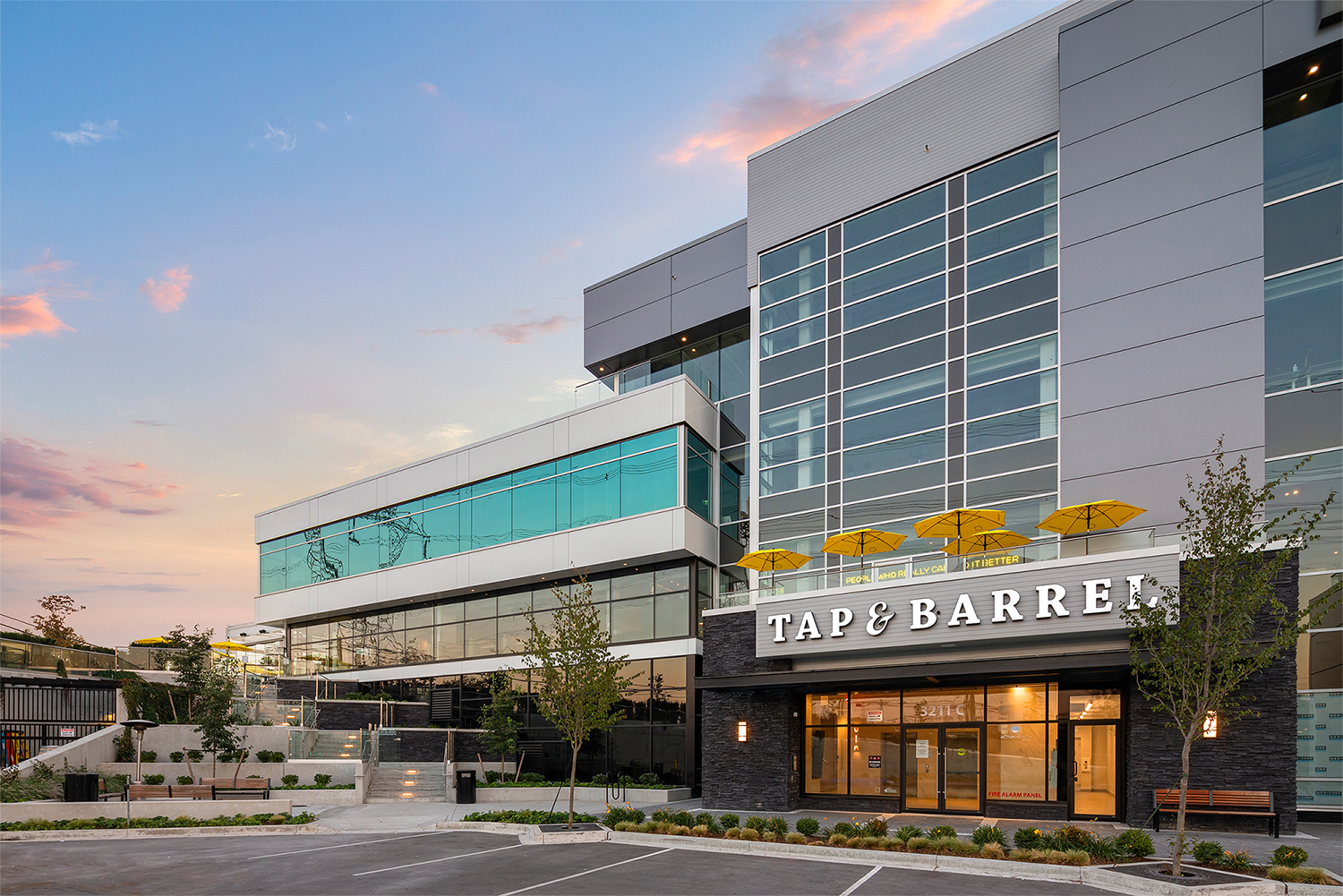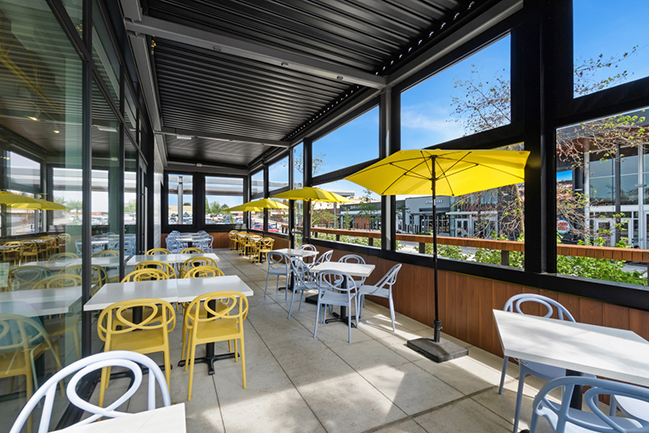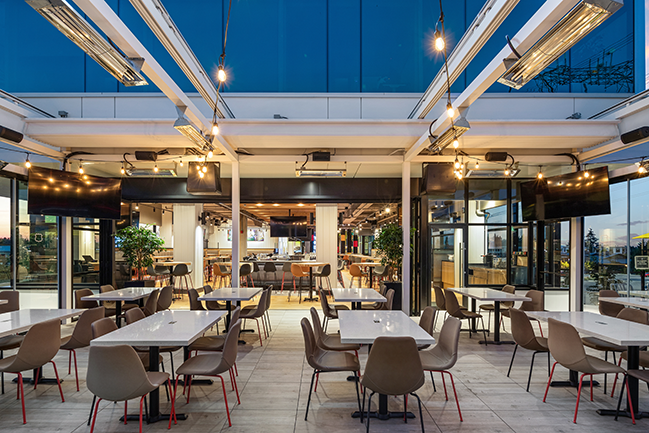Bringing the Indoors Out: How Interior Design Extends Beyond the Door
Your patio is more than just extra seating—it’s an extension of your brand. Explore how interior design brings strategy, flow, and style to outdoor dining spaces, and why patios deserve just as much thought as interiors.

Summer is patio season, and for restaurants, it’s a golden opportunity to extend both seating capacity and customer experience. While patios may appear to be simple additions—tables, chairs, and umbrellas under the sun—a well-designed patio does far more than provide extra seats. It becomes an extension of your brand, an immersive space that elevates ambiance, functionality, and the overall dining experience.
Another facet where the expertise of an interior designer becomes invaluable. Just as interior design shapes the feel and function of your indoor spaces, it plays a crucial role in bringing coherence, creativity, and strategic thinking to your exterior ones as well. Here’s how a designer’s touch can make all the difference when it comes to your restaurant’s patio.
The Strategic Value of Outdoor Spaces
Outdoor dining isn’t just a seasonal perk anymore. It’s a key part of a restaurant’s business model. Since the pandemic fast-tracked demand for open-air dining, patios have remained a priority for customers who appreciate the fresh air, relaxed atmosphere, and sense of openness. They’ve become a competitive asset, and when designed well, patios can attract new clientele, increase table turnover, and boost a restaurant’s visibility from the street.
A designer’s job is to unlock that potential, considering not only layout and flow, but also how the patio serves your business goals. Is it a casual extension of your bar? A destination dining experience with a view? A flexible space that can transition between brunch, happy hour, and dinner service? These types of strategic questions are where design begins.

Design Considerations That Go Beyond Furniture Placement
To the untrained eye, a patio might seem like a blank canvas waiting to be filled with tables and chairs, but to a designer, it's a dynamic space that must account for far more than aesthetics. They evaluate everything from sun exposure and wind protection to foot traffic patterns and how guests will interact with staff across both indoor and outdoor zones.
Here are just a few design elements that a professional would be thinking about:
- Circulation & flow: How will guests move between indoors and out? Are pathways wide enough for servers to navigate without disruption? Can doors be opened easily while carrying trays, or should they be automated or fitted with hardware for hands-free access?
- Zoning: Does the space accommodate different group sizes? Is there a comfortable mix of lounge seating, dining tables, and high tops?
- Lighting: From string lights to integrated landscape lighting, ambiance doesn’t have to fade with the sun.
- Weather adaptation: Does the design allow for shade during the day and warmth in the evening? What about cover during unexpected rain?
- Acoustics: Sound travels differently outdoors. Design elements like planters, walls, or pergolas can help manage noise and create intimacy.
Each of these factors contributes to a patio that feels as curated and intentional as the interior space it connects to.
.jpg)
Brand Integration in the Open Air
Your patio shouldn’t feel like an afterthought. It should feel like an invitation into your brand identity.
Branding in outdoor spaces is more than signage or logo placement. It’s about carrying the visual language and atmosphere of your interior outward in a way that feels seamless. This includes choosing materials, colours, and textures that are in harmony with your restaurant’s identity.
Whether your brand is refined and luxurious or bold and casual, an interior designer ensures that these qualities extend into the outdoor experience. Think custom planters that echo your interior palette, lighting that reflects your restaurant’s vibe, or upholstery and finishes that subtly nod to your overall theme. For a guest walking in off the street, the front patio becomes a preview of what’s to come—and a designer ensures that first impression is unmistakably you.

Working with the Environment, Not Against It
Outdoor design requires sensitivity to the surroundings, both natural and built. A well-executed patio design considers the location’s climate, light conditions, and views, but it also considers urban context, nearby architecture, and how to carve out a sense of place in a busy environment.
For example, if your patio is situated along a bustling street, the design might include screens, planters, or fencing to create a sense of enclosure and privacy. On the other hand, if you’re lucky enough to overlook a park or water feature, the design should enhance that connection with open sightlines and strategic seating orientation. A restaurant with close neighbouring businesses may consider a rooftop patio, offering views of the skyline while giving patrons a more secluded experience.
Designers also think seasonally. They’ll plan for spring openings, summer heat, and even shoulder seasons with features like outdoor heaters, removable walls, or stackable furnishings. It’s about maximizing usability across the seasons while minimizing maintenance headaches.

Permits, Codes, and Practical Constraints
While design is a creative discipline, there’s a technical side too. Every city has its own rules and regulations when it comes to outdoor dining; from zoning bylaws and permit requirements to fire codes and accessibility standards. Navigating those can be frustrating and time-consuming for restaurant owners.
Designers often liaise with city officials, submit required drawings, and help secure permits, all while ensuring your space remains both compliant and on-brand. From patio railings that meet height regulations to choosing finishes that are durable enough for outdoor use, a designer is your advocate in making sure the process runs smoothly and the final product is safe, efficient, and beautiful.
Patio Trends to Watch in 2025
Every season brings new trends, and 2025 is no exception. This year’s outdoor spaces are all about personality and flexibility:
- Mixed materials: Blending natural and industrial textures—think concrete paired with rattan, or steel with reclaimed wood—for a modern, layered look.
- Statement lighting: Outdoor lighting isn’t just functional, it’s decorative. Oversized pendants, sculptural lanterns, and even chandeliers are appearing on patios to create visual drama.
- Biophilic design: Plants continue to dominate, but not just in pots. Designers are incorporating green walls, trellises, and herb planters that add life and freshness.
- Multi-use zones: Patios are being designed with versatility in mind—cozy lounge areas that can become dining spaces, or flexible setups that can accommodate events and private bookings.
- Colour confidence: We're seeing bold, playful palettes that defy the neutral tones of past years. This is where branding shines—colour becomes a tool for reinforcing personality and drawing attention.
.jpg)
Ready to Extend Your Space?
At the end of the day, a patio is more than an outdoor dining area. It’s a brand experience, a design opportunity, and a smart business move. Whether you’re starting fresh or reimagining an existing space, bringing a designer into the process ensures your patio isn’t just pretty, it’s purposeful.
Want to see what’s possible for your restaurant’s outdoor space? Contact us today, or check out our other journal entries for expert tips on commercial, retail, office, and healthcare interior design.

.jpeg)
.jpeg)
.jpeg)